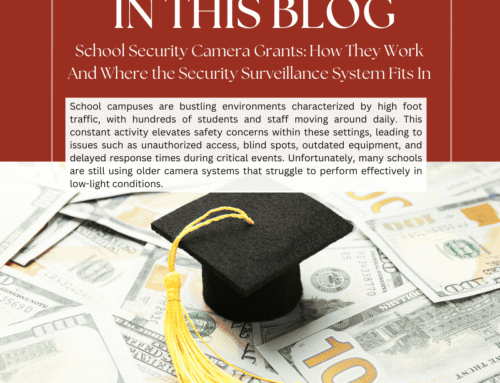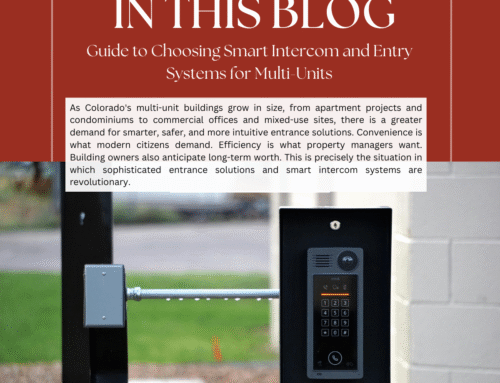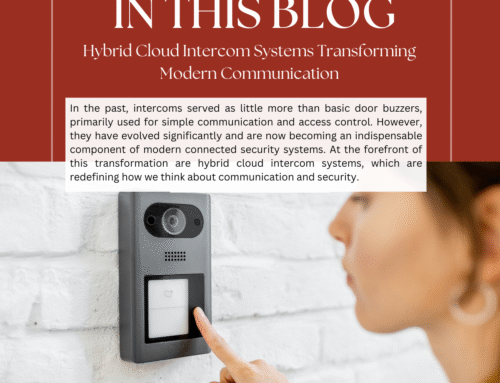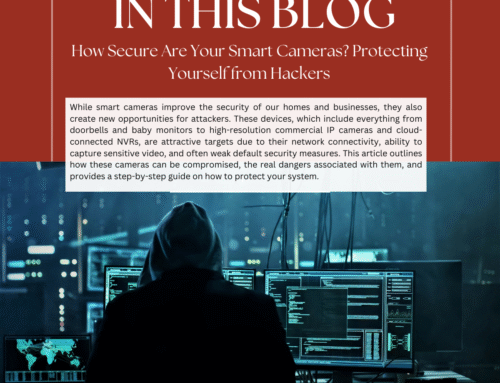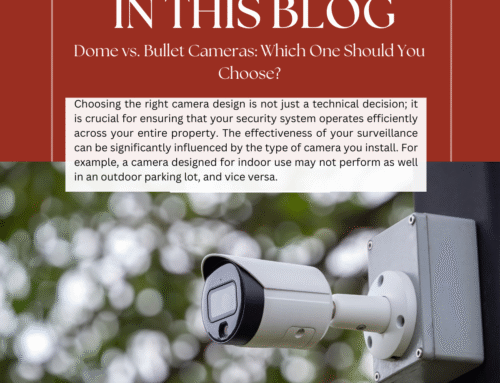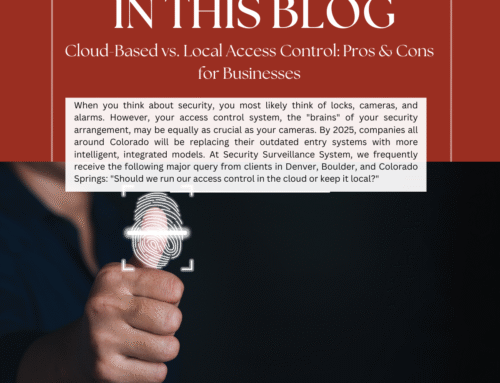NVR vs. DVR: Understanding the key differences
NVR vs. DVR: Understanding the key differences
One of the most important decisions you will face when constructing a trustworthy security surveillance system is whether to use NVR (Network Video Recorder) or DVR (Digital Video Recorder) technology. While both serve the purpose of capturing and storing video, significant differences exist in their operation, integration, and ability to accommodate future updates. Your choice will impact long-term ROI, scalability, and remote access, as well as video quality.
Understanding the differences between NVR and DVR is essential for developing a security system that provides current protection while allowing for future flexibility, whether you’re safeguarding a private home in Colorado Springs, a warehouse in Aurora, or a shop in Denver.
The Evolution of Video Recording Technology
Early CCTV systems primarily relied on analogue technology. DVRs represented a major advancement by digitizing analogue data and saving it on hard drives, offering improved image quality, easier playback, and faster retrieval compared to traditional tape-based VCR systems.
As internet speeds and network connectivity advanced, NVRs emerged. Unlike DVRs, which use coaxial cables, NVRs operate with IP (Internet Protocol) cameras that transmit data over an Ethernet network. In today’s interconnected world, this shift from analogue to IP technology has introduced flexibility, scalability, and remote accessibility as key features.
Industry statistics indicate that the demand for mobile monitoring capabilities and higher-resolution video has led to approximately a 60% increase in the use of NVR-based systems over the past five years in Colorado and other growing areas.
What is a DVR system?
A DVR system utilizes coaxial cables to transmit raw video feeds from analogue or HD-over-Coax cameras. These analogue feeds are transformed into digital video by the recorder so that they may be stored.
Key DVR Features:
- Coaxial cables (RG59/RG6) are used
- Video is handled at the recorder
- Smart features are not readily available
- A simple interface with physical monitor access is used
Advantages of DVR
Works well with the current coax infrastructure; stable wiring with little reliance on the network; affordable for small projects
DVR’s limitations:
- Low-quality images (720p–1080p)
- Limited mobile access and analytics; challenging to integrate or expand with contemporary security technology
What is an NVR System?
For IP (Internet Protocol) cameras, which process video on-site and transmit digital data over Ethernet or Wi-Fi, an NVR system is designed.
Key NVR Features:
- Compatible with wireless cameras or Cat5e/Cat6 (PoE)
- Supports 4K and ultra-HD resolution
- Makes video analytics and intelligent motion alerts possible.
- Integrated mobile and cloud access
Advantages of NVR
- Enhanced clarity (2MP, 5MP, 8MP, and 4K)
- Very scalable and simple to add cameras to
- Facilitates AI functions, including facial recognition, human/vehicle filtering, and line-cross detection.
- Perfect for combining mobile monitoring, intercoms, and access control
NVR’s limitations:
- A greater starting price
- Basic network setup is necessary.
- Reliant on the performance of the network
NVR and DVR’s Key Differences
-
Type of Camera and Transmission of Signal
DVRs are only compatible with analog cameras. These are often less expensive, but they offer fewer features and a lower resolution. IP cameras, which transmit digital signals and provide ultra-high-quality video, improved frame rates, and intelligent capabilities like object detection and facial recognition, are used by NVRs.
-
Cabling and Installation
Installing DVR systems may be challenging, particularly in large estates or campuses with several buildings, because each camera has its own power and video lines. Ethernet cables are used by NVRs to do both tasks, making installation and placement easier.
-
Resolution and Image Quality
Although HD-analogue formats can be supported by current DVRs, their maximum clarity is usually lower than that of NVRs. Sharper and more detailed images that are essential for recognizing faces, license plates, and minor motions may be produced by NVR systems, which can handle resolutions up to 4K and beyond.
-
Intelligent Integration and Remote Access
Cloud services, AI-powered video analytics, and smartphone apps may all be seamlessly integrated with NVR systems. Users may remotely check motion-tagged recordings, see real-time footage from smartphones, and get live warnings. In this regard, DVR systems are more constrained, frequently needing extra gear for remote access.
-
Adaptability and Growth
Expanding coverage or adding more cameras is simple with NVRs, as they function across a network. Multiple NVRs may be integrated across sites and monitored from a single interface by a business. However, the number of ports on a DVR is limited, which limits its potential for future growth.
-
Cost and Long-Term Value.
DVRs are often less expensive up front, which makes them appropriate for low-risk settings or small residences. However, because of their improved picture quality, remote control, and ability to integrate with cutting-edge technology like alarm systems and access control, NVRs eventually provide a higher return on investment.
Why the Future of Surveillance Is Shaped by NVR
As of 2023, over 72% of commercial installations have adopted IP-based Network Video Recorder (NVR) systems due to their remote capabilities and advanced analytics, according to the Security Industry Association (SIA). Organizations in Colorado’s bustling business districts, particularly in the Boulder tech corridor and Denver Tech Center, are opting for NVR systems to seamlessly integrate video with cloud platforms, mobile alerts, and enterprise management features.
Real-World Applications
Digital Video Recorders (DVRs) may be a more cost-effective solution for residential homes with existing coaxial wiring, especially for simple perimeter recording. However, NVR systems are rapidly being integrated into smart homes and gated communities for enhanced features like mobile notifications, video intercoms, and doorbell integration.
NVRs also offer valuable AI functionalities, such as people counting and theft tracking, which are particularly beneficial for retail establishments and gas stations. Research shows that reviewing incidents using IP/NVR footage can reduce investigation times by up to 45%, helping businesses quickly identify perpetrators.
In Colorado, industrial sites and warehouses, including those in Fort Collins and Colorado Springs, prefer NVR systems for their centralized monitoring rooms and the ability to scale with multiple cameras.
Hybrid Surveillance Solutions
A notable trend among property owners of large commercial buildings and mixed-use developments is the adoption of hybrid systems that combine DVR and NVR technology. These hybrid recorders can handle both analogue and IP inputs, allowing organizations to make incremental upgrades without needing to replace existing infrastructure.
This model is particularly popular in Colorado’s expanding industrial and retail sectors, where numerous businesses still rely on outdated coaxial systems but wish to incorporate modern IP cameras for enhanced security.
Network Safety and Cybersecurity
One of the main differences between DVR and NVR systems is their vulnerability to cyber threats. NVRs, being connected to the internet, are more susceptible to hacking or unauthorized access if not adequately secured. To mitigate these risks, modern NVRs are equipped with multi-factor authentication, encrypted connectivity, and regular firmware updates.
According to a 2024 security technology survey, over 75% of businesses utilizing network-based cameras prioritize cybersecurity assessments during installation, a trend particularly prevalent in industries like healthcare, retail, and education.
While DVRs are still vulnerable to physical tampering or theft, they generally operate as isolated devices that do not depend on networks, offering a layer of protection against online threats.
Future Developments in Surveillance Cameras
AI-enhanced NVRs represent the future of surveillance technology. These systems not only record and analyze video in real-time but also track objects, identify suspicious activity, and instantly alert security personnel. The growing popularity of cloud-managed NVRs simplifies monitoring by enabling control, access, and storage from any device.
Conversely, DVR systems are gradually being developed into specialized equipment suited for installations with limited budgets or older configurations. While they remain reliable, they face challenges in keeping up with the rapid integration of automation, security, and IoT technologies.
Frequently Asked Questions
Are NVRs and DVRs compatible?
Answer: Indeed. Both analogue and IP cameras can be supported by hybrid recorders, enabling incremental improvements without requiring a complete hardware replacement.
For remote monitoring, which system is superior?
Answer: NVR systems are better for remote viewing since they are made to be network-connected and accessible through secure web portals or mobile apps.
Is it more difficult to deploy NVR systems?
Answer: If network cabling is already installed in your house, it may be easier. PoE technology reduces clutter by allowing a single connection to transport both data and power.
Is internet access necessary for NVRs to operate?
Answer: Not always. Although they may record locally, remote viewing and cloud backup require internet connectivity.
What about NVR privacy issues?
Answer: Strong passwords, frequent firmware upgrades, and encrypted connections are essential for preserving privacy because they are networked.
How much room do I require for storage?
Answer: Several terabytes of storage may be required by an NVR to record 4K video continuously. Options for cloud backup can be added to this for redundancy.
Are DVRs going out of style?
Answer: Although they are still helpful for low-cost or small-scale deployments, their utility is dwindling as IP-based solutions take over the market.
Which is better suited for homes in Colorado?
Answer: NVRs are perfect for smart integration and mobile control for homeowners in metropolitan locations like Denver or Boulder. DVR systems could still function successfully in older or remote residences with limited network connections.
In conclusion, whereas NVR and DVR systems both capture and secure video footage, their underlying technologies determine how well they meet the expectations of modern surveillance. NVRs are the best option for contemporary setups because of their adaptability, scalability, and integration with intelligent security features. DVRs are still useful for legacy or budget-conscious installations, but as technology advances, network-based recording is quickly taking the place of DVRs as the new norm for reliable, future-proof security systems.



